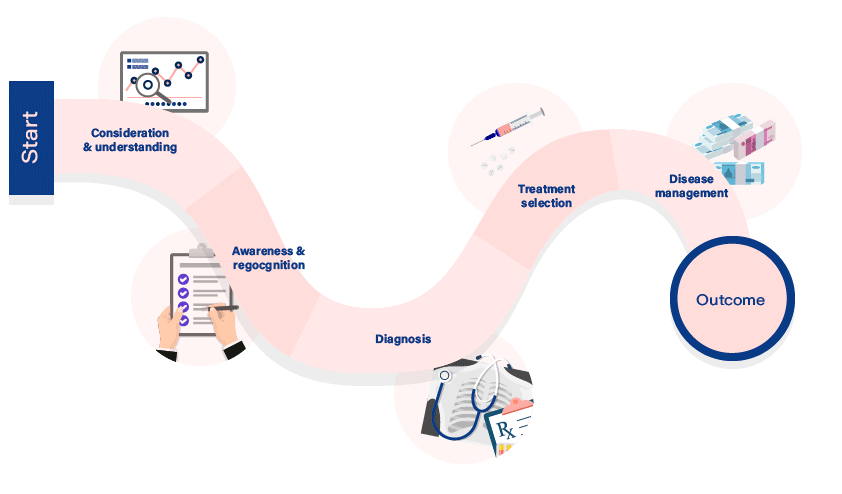Communications to support preventative treatment
Healthcare and wellness industries strive towards preventing health issues rather than trying to fix already-there problems. What exactly does this mean, though? How can we encourage the public to take responsibility of their own wellbeing? How can digitalisation help with this?

Here at Myy we are certain that the right information helps the patient to get actively engage in their own treatment. When the patient is involved in the decision-making process, they assume more responsibility of their own treatment and are more likely to agree to be treated. The most important part of the shared decision-making model is that the patient receives accurate information at the right time – the Internet is full of diverse, scientifically back-upped information and detailed advice on many diseases, but also featured plenty of inaccurate or even false and dangerous claims.
In addition to making the patients part of the treatment, people should be encouraged to take responsibility of their own health already far earlier. Prevention is important for the individual’s health and wellbeing but saves the society and the economy from a massive burden. The Finnish Union of Practical Nurses SuPer estimated in 2014 that, for instance, the cost of wounds of diabetes patients that lead to amputation was around 25,200 euros annually, while similar wounds when treated properly accumulate to only 7,720 euros per annum. A preventative treatment model can create clear economic savings. A part of the costs also manifests as lost years at work. When the public realises the significance of their own role in preventing illness, there will be savings in disability pension and a reduction in sick leave.
Changing habits with the help of contents
There are plenty of follow-up and measuring opportunities especially when it comes to the most common national diseases. Many are familiar with measuring blood pressure, blood sugar and cholesterol levels, however, the actual practical preventative measures are easily forgotten. How can healthcare professionals emphasise the role of individual responsibility in preventative treatment? How to motivate people to take care of themselves already before the first symptoms, or at least, immediately after they arise?
We believe that an important part of the process is to provide the public with the right contents at the right time. Receiving information about the risks associated with various diseases, how to measure them and how their prevention from a reliable source makes it easier for an individual to change their behaviour for better. Services need to be flexible and personalised; with digitalisation, as nearly all other services are available any time, people want access to healthcare services without wait, regardless of time and place. This provides a channel to communicate personalised preventative content. Utilising digitalisation in healthcare is a rising trend. For instance, Business Finland launched the Smart Life Finland programme that aims to renew the healthcare industry’s way of business, increase exports and create new business ecosystems.
Use patient journey maps for targeted content
A patient journey map is a handy tool for healthcare industry operators: a description similar to a customer journey map that helps to visualise a patient’s journey from the time before a diagnosis throughout treatment until stabilisation. With the goal being disease preventing treatment, the focus is in the first part of the map. However, preventative treatment can also be viewed to be associated with other parts of the journey, as treatment commitment – or the lack of it – can have long-lasting effects for both the patient and the society.

Original picture: Signals Analytics
Consideration and understanding
When a person begins to suspect that health-wise not everything is as it should be, they often start to look for information independently. In 2015, 5 % of all Google searches was related to health topics and the number of searches related to serious diseases increase constantly. At the time of information search, personalised contents about disease prevention and measuring may help the individual to find reliable information that guides them to make the right decisions regarding their lifestyle and treatment.
Awareness and identifying the disease
According to a study by Accenture, 64 % of patients would provide their personal information to receive free and reliable information and support. Preventative treatment requires that the patient can trust the information and advice they receive. Moreover, this advice should be personalised and targeted for every individual patient based on their particular challenges and concerns. If a patient has access to a reliable platform where they can look up information and tests based on their first symptoms, based on these searches we can provide them with the right contents – at the right time. A closed, data-safe platform may also encourage patients to be more specific with their symptoms than in, for instance, Google searches.
Diagnosis
At this stage the individual is already certain that they need an official diagnosis provided by a healthcare specialist. Choosing the right service provider may be challenging, but if the individual is already introduced to and encouraged to commit to a specific operator in the earlier stages of their patient journey, it is easier for them to choose a familiar party that has already provided them reliable information and support.
Treatment
When it comes to choosing the right treatment for the patient, making the patient part of the decision-making is crucial. An individual’s values and wishes affect their decision whether or not to be treated. Healthcare professionals should consider the patients’ proactivity – many look up alternative treatment options online, and if there is no discussion between the patient and their doctor or nurse, commitment to the treatment may be weaker.
Managing the disease
Once the treatment has been chosen, it is important to get the patient to commit to the treatment also in the long-term. According to a 2015 study, 18 % patients with a prescribed medicine stopped taking their dosage after a month, and 52 % said the reason to be the perceived inefficiency of the treatment.[i] The right contents can support an individual’s understanding of the function of a medicine and the possible consequences of stopping the treatment. The goal of a treatment is to get rid of the disease altogether or stabilising it. At this stage, an individual may need support and networks. These can also be targeted and provided by a healthcare operator for their patients.
Producing and targeting contents is not your company’s forte? Let us know – our awarded healthcare communications team is here to help you out.
[i] Gregory Simon et al., Patient information: Depression treatment options for adults (beyond the basics). UpToDate, 2015.



